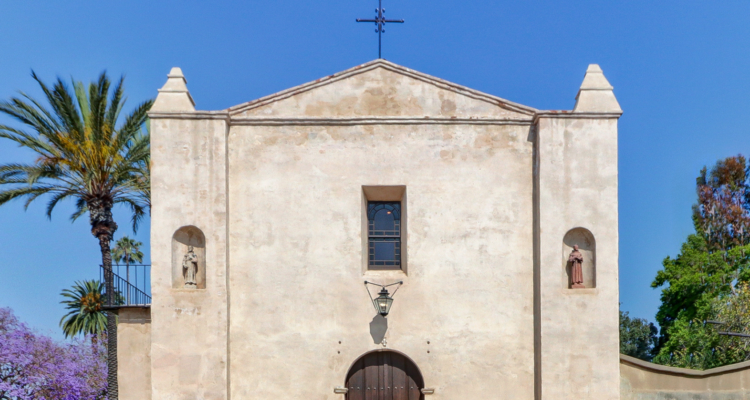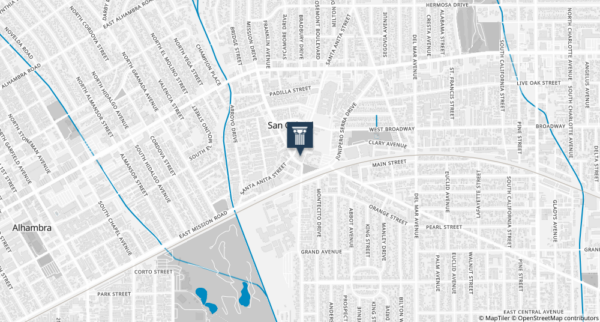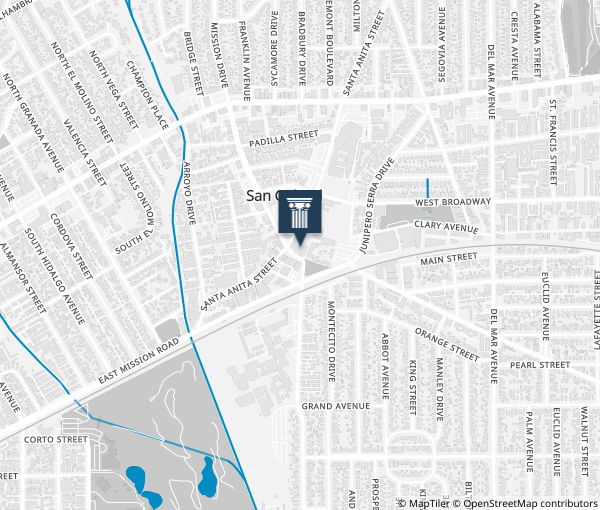
Place
Mission San Gabriel Arcángel
Mission San Gabriel Arcángel, a key piece of California history, was restored after a fire, preserving its heritage and cultural importance.


Place Details
Address
Website
Architect
Year
Style
Property Type
Government Officials
Mission San Gabriel Arcángel, founded on September 8, 1771, is one of California’s most significant historical and architectural landmarks. Established by Franciscan friars under the direction of Father Junípero Serra, it was the fourth of 21 missions built in Alta California. Originally intended to serve as the mission for what would become Los Angeles, it was first constructed near the Rio Hondo but moved in 1775 due to flooding. Built on the site of the Tongva village of Toviscanga, the mission played a central role in Spanish colonization, though at great cost to the Indigenous people, who were forced to labor on its construction and operations.
Unlike the traditional adobe structures of other missions, Mission San Gabriel stands out for its fortress-like design. Inspired by the Moorish architecture of Spain, the church was designed by Antonio Cruzado and completed in 1805. Its thick stone-and-mortar walls, capped buttresses, and narrow windows give it a distinctive appearance. A six-bell campanario (bell tower) adds to its unique character. Over the years, the mission became one of the most productive, supplying food and goods to other missions. It also introduced large-scale viticulture to California, helping establish the region’s winemaking tradition.
For over 250 years, the mission has served as a gathering place for generations of families who came to celebrate baptisms, weddings, and community events. Students have visited on field trips, and many have returned as adults to share the experience with their own children. As an active parish and historic site, the mission remained a vital part of the community—until tragedy struck in 2020.
On July 11, 2020, a devastating fire severely damaged the mission just before its 250th anniversary. The blaze destroyed the roof and caused extensive smoke, fire, and water damage to the church’s structure, artwork, and artifacts. The steel beams added in a 1990 retrofit were irreparably twisted by the heat, while the original redwood ceiling and friezes were almost completely lost.
Following the fire, a large-scale restoration project began, involving preservation architects, structural engineers, conservators, and skilled craftsmen. Efforts focused on salvaging and restoring as much original material as possible while ensuring structural integrity. The team analyzed historic photographs, HABS (Historic American Buildings Survey) drawings, and paint samples to determine the mission’s original appearance. They discovered that the sanctuary ceiling was originally stained redwood rather than painted, and this finish was restored. Rebuilding efforts included replacing the destroyed wooden trusses and roof shingles with historically accurate materials. Steel beams were either reinforced or carefully replaced to maintain structural stability. Artisans meticulously recreated lost decorative elements using surviving fragments and historical documentation. The reredos and altar, which had been altered over time, were restored to their earlier configuration. Restoration extended to exterior and interior plaster, wooden doors and windows, railings, light fixtures, pews, and religious artifacts.
The restoration process also provided an opportunity to further acknowledge the history of the Tongva people, whose forced labor built the mission. A new educational element was added, including a viewing window in the nave wall to show the original rock and mortar construction, helping visitors understand the effort involved. Additionally, a Native American garden was created in collaboration with Indigenous and mission representatives. The garden serves as a space for reflection and features native plants, a water feature, wood benches, and a kiiy—a traditional thatched Tongva dwelling.
Mission San Gabriel Arcángel holds a distinguished place among California’s historic sites, recognized at multiple levels for its cultural and architectural significance. It was designated a California Historical Landmark in 1935, acknowledging its role in the early history of the state. In 1971, the mission was added to the National Register of Historic Places as part of the California Mission Thematic Group, further cementing its importance as one of the 21 missions that shaped the region’s development. The mission is also a Los Angeles County Historic Landmark, reflecting its significance within the broader community.
Today, Mission San Gabriel continues to function as an active parish while welcoming thousands of visitors each year. The completed restoration brings the church closer to its historic appearance from the late 19th and early 20th centuries, preserving its architectural and cultural significance. The project not only rebuilt a historic structure but also deepened public understanding of its complex history.
For many in the community, the mission represents a place of deep spiritual and cultural connection. Its restoration and reopening brought relief and joy, restoring a place where generations have gathered for baptisms, weddings, and celebrations. Supported by public donations and conservation efforts, its renewal ensures that the mission will continue to stand as a symbol of resilience and remembrance for generations to come.
The San Gabriel Mission was awarded a 2025 Preservation Award.
Owner: Archdiocese of Los Angeles
Contractor: Spectra Company
Project Lead/Structural Engineer: Melvyn Green & Associates
Preservation Architect: Drisko Studio Architects
Construction Manager: Archdiocese of Los Angeles
Conservator: RLA Conservation
Gabrieleno-Tongva Landscape Design Build: Ramirez Design Inc.
Wednesday, April 23, 2025
2025 Preservation Awards Celebration
Celebrate the L.A. Conservancy’s 2025 Preservation Award recipients at Paul R. William’s spectacular Founder’s Church in Koreatown!







